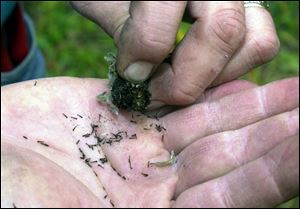
Autumn seeds can yield next year's blooms
10/10/2001How would you like a handful of free seeds? Mother Nature has been growing them all summer for you. Now is a good time to get out there and find her treasure. With a little research and a lot of walking, you can find free native seeds to plant in your garden. Finding and collecting native seeds can become as addictive as collecting baseball cards or antiques.
As the plant's life cycle ends, many perennials will produce seeds. These seeds will drop once the flowers, foliage, and stem have withered and died. The seeds will be in place to grow a new generation of plants next year.
Timing is important for seed collecting. It is almost like jumping rope with two friends. You need to observe the rhythm of the plant's life cycle and jump in at the right time.
Rick Bryan has become a native plant connoisseur. He has owned Portage Valley Plant Co. for more than 11 years and modestly considers himself an advanced amateur when it comes to collecting seeds. Mr. Bryan's Holland company sells perennials wholesale to area nurseries. He says he does about 20 percent of his business in native plants.

Rick Bryan shows seeds from a black-eyed Susan. Most wild seeds will last up to a year if they are stored properly.
About five or six years ago, Mr. Bryan took a walk through Kitty Todd Preserve. He says one of the tour guides explained the importance of native plants in the life cycles of bugs and birds. “When they said it was difficult to find a source for native plants and seeds, it made me curious,” he said. Mr. Bryan talked with experts at Kitty Todd Preserve after the tour about collecting plants and seeds and has had a close relationship with them ever since.
He says, “Look for plants with dried seed heads along ditch banks.” If you want a special grass or plant in a farmer's field, be sure to ask permission before you collect.
“Always get a positive identification on the plant before you collect it. Be sure you are not collecting and replanting a noxious weed like purple loostrife,” says Mr. Bryan. “Many times people get the golden rod weed mixed up with asters.”
The beautiful flowers and leaves you fell in love with earlier in the season are gone by now and the plant may look brown and ragged. Mr. Bryan suggests marking the area while the plants are still identifiable.
“You have to wait until the seed heads are dry before collecting them,” says Mr. Bryan. “By that time, it is hard to tell what kind of plant it is. Scout out areas in the summer or early fall to know what the plant is.”
Collect the seeds just before the plant completely dries up and drops them on the ground, he says. “If you collect the seeds too early, they may contain too much moisture and rot while in storage.”
BOTANICAL COLLECTABLES
Some seeds need to go through the seasonal cycle of cold winter and warm spring before they will wake up and germinate. “Columbine is one of those seeds that needs to be cooled,” says Mr. Bryan. “I have seen some gardeners plant their seeds in trays filled with a soil mix, then leave them outside all winter with a cover on them.”
Some seeds have a very hard shell. “Wild lupine seeds need to be scraped or softened before they will be able to germinate,” he says.
According to Mr. Bryan, some seeds that can be collected after early September are from bergamot, black-eyed Susan, butterfly weed, columbine, and some sunflowers. Asters, blazing star and some grasses are best collected late in September and early October.
“Plants like Joe Pye weed, boneset, and ironweed and many other grasses can be collected in late October,” says Mr. Bryan.
This collection time will vary every year depending on the year's growing conditions. Some years plants may mature faster if it has been a dry or stressful summer. They may mature slower if the summer is cool and wet.
PACKAGING
You can store your botanical treasure in your refrigerator. “A cool, dry place is best and your refrigerator will work. Keep them in a spot around 40 degrees.” says Mr. Bryan.
Paper is preferred over plastic when storing your seeds. Package your seeds in a paper bag or envelope since the natural fibers will let air circulate around the seeds. Clear plastic containers and bags can hold heat and moisture, causing your seeds to deteriorate.
Most wild seeds will last up to a year if stored properly. Before spending a lot of time planting them, you can do a simple germination test. Place a few seeds on a moist paper towel and close it up in a sealable plastic bag. Put the bag in warm dark place and monitor it daily. If your seeds are still active, you should see them sprout in a few days.
You need to collect a lot of seeds just to get a few to grow. Mr. Bryan says, “Wild seed collection can be tough sometimes. Their germination rate may be less than 50 percent.” Seed companies spend lots of time and money testing the germination rate of their plants. You may have better luck getting their seeds to grow than Mother Nature's.
When trying to decide what seeds to collect, Mr. Bryan says, “Look to nature as an example. Hardy plants with strong genetics will survive.”
Kelly Heidbreder is The Blade's garden writer. E-mail her at kheidbreder@theblade.com.